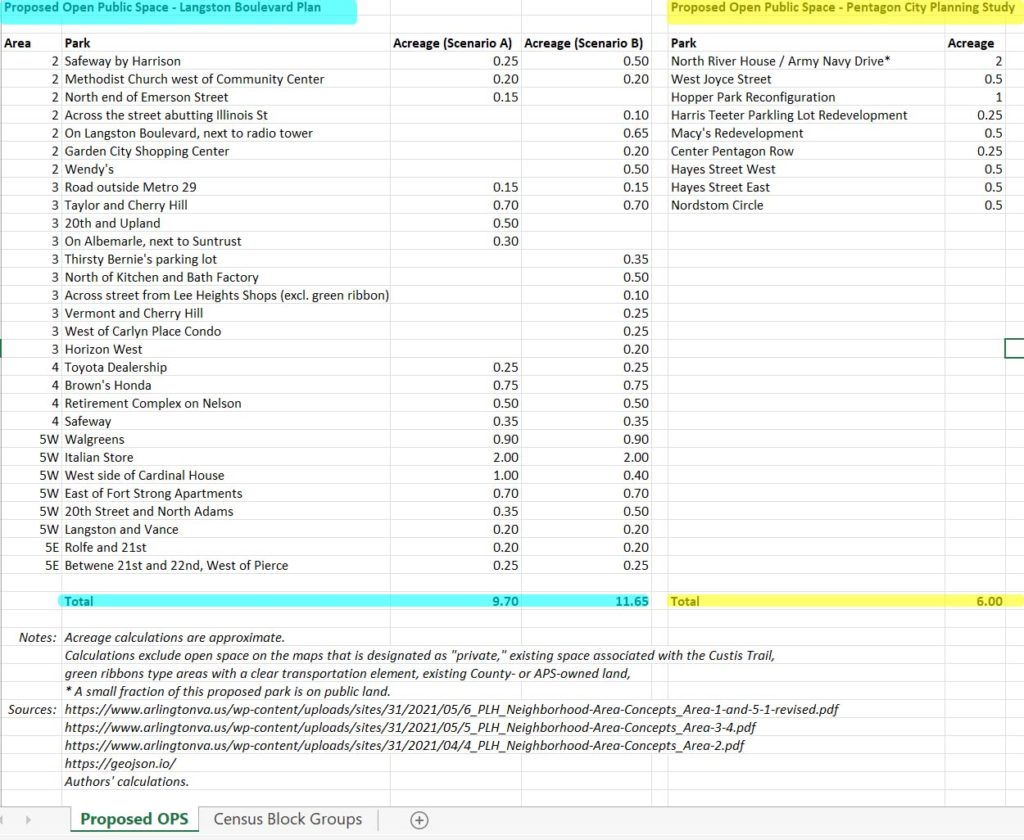There is a lot of concern about this Plan including both how increases in double to triple density throughout Pentagon City will not provide sufficient green space and facilities, a lack of impact analyses and much more. In fact access to green space will likely decrease from existing levels for Pentagon City and River House residents. Meanwhile other County plans with similar density increases will see nearly double public space increases as Pentagon City will receive. That is not equitable and there is valid concerns among the community about this Plan moving forward without addressing many issues.
The plan is progressing full-steam ahead, and has passed all commissions and heads to the County Board this Saturday, February 12, where there is a good chance it will be approved as-is, despite serious concerns about the impacts to parks and open space. The County needs to hear from you that we need much stronger commitments to parks and open space. Email countyboard@arlington.va.us, leave a message at 703-228-3130, or speak Saturday.
Editorials on Impending Impacts to Parks and Facilities
Below are highlights from the February Aurora Highlands Civic Association newsletter which discusses many remaining issues. Additionally, analysis by Arlington Analytics comparing the green space additions of Pentagon City Plan to the similar-sized Langston Blvd Plan show concretely how this Pentagon City Plan will make our community’s already inequitable access to green space compared to other parts of Arlington, much greater. The FoAHP past newsletter documents the issues throughout the plan and the process. Read the Aurora Highlands Civic Association newsletter with both editorials in their entirety https://aurorahighlands.org/news/february-2022-newsletter/
Highlights from Editorial by Scott Miles in AHCA Feb. 2022 Newsletter
(Aurora Highlands Civic Association President 2018-2021)
“I do not currently support the proposed Plan, because it still has serious issues that are not good for Aurora Highlands:
- It does not provide nearly enough open, green, and recreational space.
- It does not guarantee essential basic community facilities like libraries, community centers, and schools will be provided.
- It is not adequately understood by residents impacted the most.
- And perhaps most concerning, the Plan pushes critical public facilities discussions on parks, recreation, schools, libraries, community centers, to future plans that will pit neighbor against neighbor as we fight over space the County knows is insufficient.”
“Neighborhood wars over insufficient space. The common theme throughout the Plan is that Virginia Highlands Park is the fallback location for all public facilities. A school. A community center. A library. More recreation. Very little of this is feasible – there’s simply not enough space and we have contention over it already today. This is overloading the long-promised ‘master planning’ process for the park, and will pit neighbor against neighbor as we fight over facilities, all of which we need. That is not fair to our neighborhood. We need to see now how this is feasible, and if it isn’t, there must be a commitment to providing additional land, less density or requiring facilities be located elsewhere in this area.
All of this becomes more frustrating in comparison to the original 1976 PDSP. That plan provided roughly the same development increase as this update. And it also committed to 11 for the park. And 1.67 acres with a Library, Fire Station, and Community Center. And at least 1 acre park space in each site plan. And a 300-unit Nursing home (or 3 acres). And 300-unit subsidized housing (or 3 acres). Plus new streets, bike lanes, etc. The deal this plan provides is embarrassing in comparison. If the same priorities back then were applied to RiverHouse, just that parcel alone would provide 7.7 acres of park space. Instead, the Plan commits to 3.5 and an undefined ‘Green Ribbon'”.
Highlights from Editorial by Ben D’Avanzo in AHCA Feb. 2022 Newsletter
(AHCA rep to the Sector Plan and AHCA Vice President as of 2022)
In his editorial, D’Avanzo shares his optimism on things like “Badly Needed Neighborhood Planning,” “Addressing the Housing Shortage”, “Affordable Housing”, “Bike and Pedestrian Improvements” and so on. But with respect to park issues, D’Avanzo shares his concerns;
“Improved Public Space – A major criticism of the plan, one that I share, is that it does not promise a net increase in green space. However, the plan instead focuses on improving poorly designed, generally privately owned, open space and ensuring they do not develop in the future through public ownership. This includes the depressing spaces outside the Nordstrom and in-between the TSA and DEA buildings, as well as the underutilized and often ignored Grace Murray Hopper Park. The plan also has new requirements, added thanks to community input, for minimum tree and planting requirements for every development, and it requires a park within a 10 minute walk for every resident.”
Lack of Equity: Pentagon City is being Shortchanged Compared to Other County Plans
Is the Pentagon City Plan even Equitable with Respect to Other Similar County Plans? Apparently not. Pentagon City is getting about half as much public green space as a similar north Arlington Plan of similar density increases. Why are we getting shortchanged?
Jon Huntley of Arlington Analytics writes, “To see how the development in Pentagon City is affecting availability of open space compared to the rest of the county we compared the Pentagon City Planning Process (PCPS) to the Plan Langston Boulevard (PLB) process, which accommodates similar population increases.
The early PLB draft plan shows an increase of public open space—excluding roadway features, green-ribbons, the area around the Custis trail, and existing county properties—of roughly 10 and 12 acres for the less dense and more dense scenarios respectively. These investments are significantly larger than the 6 acres of similarly-defined open public space highlighted in the Pentagon City study area for a similar number of new residents. PLB calls for a little less than two times the new public open space per resident. Moreover, the Pentagon City Planning Study projects a large loss in private green open space, particularly around River House, making the difference feel more acute.”
FoAHP published a review of the issues with our parks and the Pentagon City Sector Plan last year. This informative article shows how our “new” parks are really just existing parks and the inequities of green space access. http://friendsofahparks.org/pc-planning-study/
To read the full plan, visit the Arlington County Pentagon City Planning Study site.

